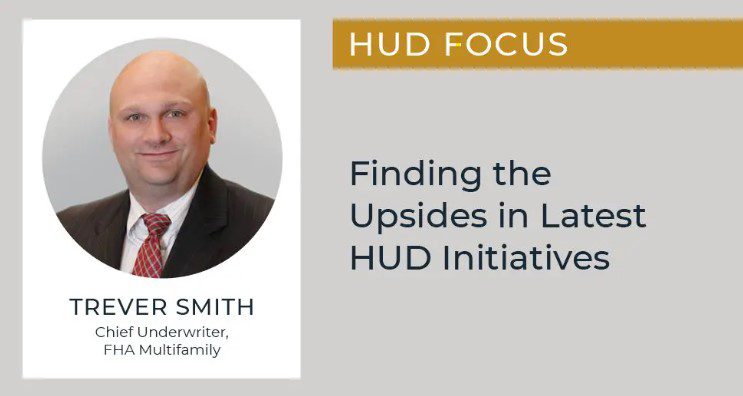This is part one of a four-part series on the latest financing opportunities under HUD.

The United States Department of Housing and Urban Development (HUD) has been working on new lending initiatives to keep up with extreme market fluctuations.
HUD took significant steps over the past year to better accommodate borrowers, including refining some of its pilot programs, implementing new incentives, and raising the Federal Housing Administration (FHA) multifamily large loan limit from $75 million to $120 million.
Owners and developers seeking HUD financing have unique opportunities going forward with some key caveats.
While lending volumes fell across most markets in 2023, largely due to elevated interest rates, there are a handful of new HUD measures that owners and developers of market-rate multifamily, affordable housing, and seniors housing and healthcare should be aware of. These include adjustments to the Rental Assistance Demonstration (RAD) program and renewed talks around use of the Section 207 (m) program for the creation and improvement of manufactured housing communities (MHC).
Here is a closer look at how borrowers can make strategic decisions with their HUD financing in 2024.
Paving the Way for Simplified Underwriting
The increase in the FHA multifamily large loan threshold went into effect last summer following a HUD risk analysis and industry feedback around the steady rise in housing and construction costs. HUD last updated its large loan threshold in 2014.
The most recent changes allow more multifamily loans to employ standard underwriting processes when being submitted for FHA insurance. A key policy revision also allows HUD to annually update the large loan limit based on adjustments for inflation in the MAP Guide. The FHA will review the threshold each year with the possibility of future annual increases of $5 million.
These revisions are intended to simplify underwriting for multifamily housing development and enable the federal agency to keep better pace with market fluctuations without causing “undue risk to the FHA insurance fund,” per HUD.
Staying on the Greener Side of Retrofitting
As part of its ongoing sustainability and climate efforts, HUD published new funding support under its Green and Resilient Retrofit Program (GRRP) this May and awarded $18 million in grants and loan commitments to the first wave of GRRP participants in September.
The GRRP program—established in August 2022 under the Inflation Reduction Act—has more than $800 million in grant and loan subsidy funding and $4 billion in loan commitment authority. Owners of properties who participate in HUD-assisted multifamily housing programs and take measured efforts to cut down on energy and water waste are eligible for the additional funding.
Given today’s many climate impacts and rising insurance costs, HUD borrowers looking to best position themselves for future financing can benefit from taking proactive measures.
Using HUD’s RAD Program for Improvements
To keep up with rising costs and provide more funding for much-needed upgrades, HUD also recently adjusted its formula to allow for higher rents under its RAD program. The RAD program launched in 2012 as a way to preserve and improve public housing and address a $26 billion backlog of deferred maintenance nationwide.
HUD expanded the program in 2018 to support Section 202 project rental assistance contract (PRAC) transactions, which cover capital improvements on affordable housing for low-income senior, aged-restricted, and disabled tenants.
The revamped RAD program allows owners of three legacy HUD programs—Rent Supplement, Rental Assistance Payment, and Section 8 Moderate Rehabilitation—to enter long-term contracts to fund improvements. There are about 2,000 Section 202 PRAC properties that are owned and operated by nonprofit organizations.
In an example of a successful RAD-for-PRAC conversion, Senior Managing Director Tracy Peters and Associate Director Dale Giffey, on Lument’s affordable housing production team, closed an FHA Sec. 223(f) refinance for a multifamily property for seniors in Garland, Texas. This unique deal helped preserve and provide much needed funds for the renovation of several dozen apartments for low-income senior tenants without putting the owner at a financial disadvantage.
Pushing for New MHC Financing Opportunities
With urging from industry stakeholders and HUD Secretary Marcia Fudge, the FHA has been looking to restart the use of the Section 207(m) program to provide more funding for the construction and rehabilitation of MHCs. Between 2001 and 2013, HUD financed just 18 manufactured home parks under the program. Lument worked with borrowers to close 10 of those deals.
Though the program has remained mostly dormant over the past decade, loan terms for Section 207(m) financing follow the 221(d)(4) program for construction and substantial rehabilitation of multifamily rental properties and housing cooperatives with 85% loan-to-cost (LTC) and 1.176x debt service coverage ratio (DSCR).
Given that few HUD staffers specialize in MHC underwriting, many industry professionals expect HUD to look for transactions located in strong markets with very experienced MHC developers and lenders.
The 207(m) program facilitates the construction and rehabilitation of MHCs—the program cannot be utilized for refinance or acquisition financing. In the past, on a limited basis, HUD would waive the “rehab” requirement, which essentially made Section 207(m) function as a refinance program. While HUD is not expected to consider that waiver going forward, the federal agency has a longer-term goal of exploring the possibility of having MHCs eligible under the low-cost and non-recourse 223(f) program.
Leveraging Lument’s HUD Expertise for Future Growth
As HUD further improves upon its lending programs and works towards upskilling its staff to meet today’s market demands, there will likely be even more opportunities for market-rate multifamily, affordable housing, and senior housing and healthcare borrowers going forward.
As the leading HUD/FHA lender in the U.S. market by loan count for fiscal years 2023 and 2022, Lument is fully equipped to help borrowers navigate the latest guidelines with Multifamily Accelerated Processing (MAP), Section 232 Lean, and other insured loan transactions.
Contact Lument to find out more about HUD’s latest efforts and guidelines and make sure to follow the rest of this series for the latest insights on HUD financing opportunities.